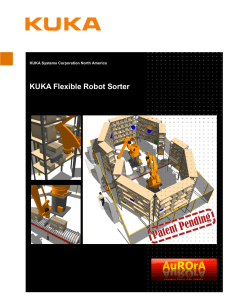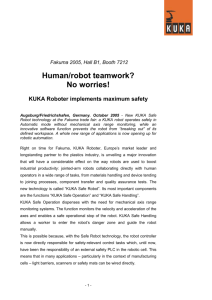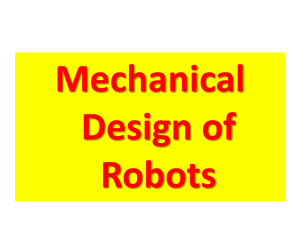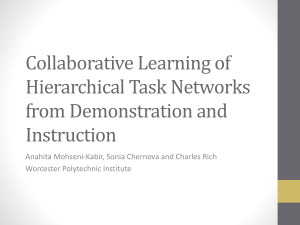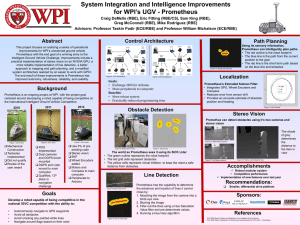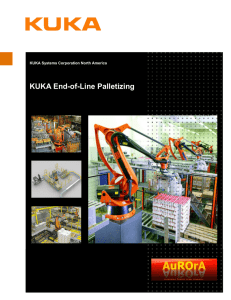PPTX
advertisement
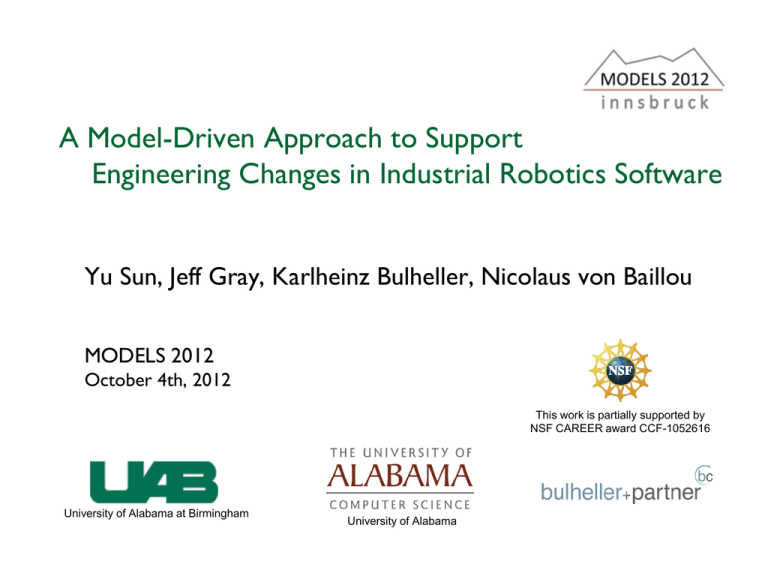
A Model-Driven Approach to Support Engineering Changes in Industrial Robotics Software Yu Sun, Jeff Gray, Karlheinz Bulheller, Nicolaus von Baillou MODELS 2012 October 4th, 2012 This work is partially supported by NSF CAREER award CCF-1052616 University of Alabama at Birmingham University of Alabama Robotics Development Robotics development and application is becoming increasingly important and critical in industrial automation contexts. 2 Project Background Collaboration between academia and a software vendor to a large European auto manufacturer Over 600 welding robots are used in the plant 3 body variants 4,000 weldspots per body 3 Challenge 1: Adapting Engineering Changes Many low-level implementation details based on proprietary robot programming languages Time intensive to maintain joint information (weld spots, studs, seams, etc.) Change of quantity Change of locations Change of configuration Change of action sequence 4 Challenge 2: Satisfying Timing Requirements Timing and schedule are critical for both safety and efficiency Timing considerations not native to most robot languages Optimizations are always needed Reduce the number of actions Reduce task completion time Optimize action sequences Optimize the movement path 5 Challenge 3: Supporting Multiple Platforms Robots from different vendors are used in different plants to produce the same product The same task logic has to be programmed in different languages A ripe context for applying MDE! 6 AutoMax Solution Control Code AutoMax enables users to plan the schedule, build robot action model, generate code, and analyze timing requirements based on digital master information. Schedule Planning & Analysis Models 7 AutoMax MetaModeling AutoMax Modeling Environment AutoMax Metamodel Conforms To AutoMax Model Generates KUKA Code KUKA Code Framework AutoMax MetaModeling First Step: Manual reverse engineering of legacy robot code to build the metamodel 9 AutoMax MetaModeling Robot configuration Robot actions Action properties 10 Using Models to Facilitate Engineering Changes Using MDE, software evolution is realized by model evolution Metamodel Model0 Code0 M0 Model1 M1 Model2 M2 … M n Modeln C0 Code1 C1 Code2 C2 … Cn Code2 Change robot models, and re-generate code automatically Using Models to Facilitate Engineering Changes The number of changes on robot programs can be large With models, changes are recorded and can be easily tracked, compared to tedious nature of Excel-based maintenance Incorporating Timing Requirements in Models Traditional planning is still done manually (e.g., Excel) Programmers take the planning document and implement specifications Verification is done manually Changes are needed back and forth Incorporating Timing Requirements in Models AutoMax incorporates timing and schedule planning into the initial models Incorporating Timing Requirements in Models The actual timing schedule can be visualized anytime to compare the planned schedule so that adjustment can be made Intelligent Features in AutoMax Optimize robot actions automatically Geometric navigation of robots in 3D-space Model analysis assists in Understanding correct model configuration and connections Detection of timing violations Legacy Code Benefits from AutoMax AutoMax Modeling Environment Digital Master DSL AutoMax Metamodel Sub TDSL Conforms To Digital Master DSL Grammar Conforms To AutoMax Model Input Data Digital Master DSL Input Generates KUKA Code KUKA Code Framework A textual DSL is defined for the legacy configuration so that it can be directly converted into AutoMax models Legacy Code Benefits from AutoMax The textual DSL is implemented using XText, which is mapped to the metamodel defined in EMF and GMF. Diverse Code Generators for Multiple Platforms Platform Independent Automax The goal of AutoMax is to support multiple platforms by enabling platform-specific code generation from platformindependent models Platform Specific KUKA ABB … Improved Code Architecture / Framework Legacy Source Code Optimized Source Code The code generation framework assists in improving the code architecture / framework by providing an optimization context of digital master code. Models 20 Ongoing AutoMax Integration AutoMax is being incorporated with a commercial robot pipeline and analysis platform (RobMax) Conclusion and Future Work AutoMax Solution: a high-level modeling environment to plan a robot schedule, model the robot control, and generate code automatically Adapt to evolving engineering changes Handle timing requirements across multiple robot interactions Automate the manual planning cycle from digital master input through code generation Future Work Extend the generation framework to cover multiple proprietary robot languages The whole modeling environment implementation is highly dependent on metamodel, so metamodel evolution has a high cost Extend focus beyond automotive domain (and beyond specific manufacturer needs) Round-trip interaction with Digital Master Thank You Questions? Comments? This work is partially supported by NSF CAREER award CCF-1052616 University of Alabama at Birmingham University of Alabama



